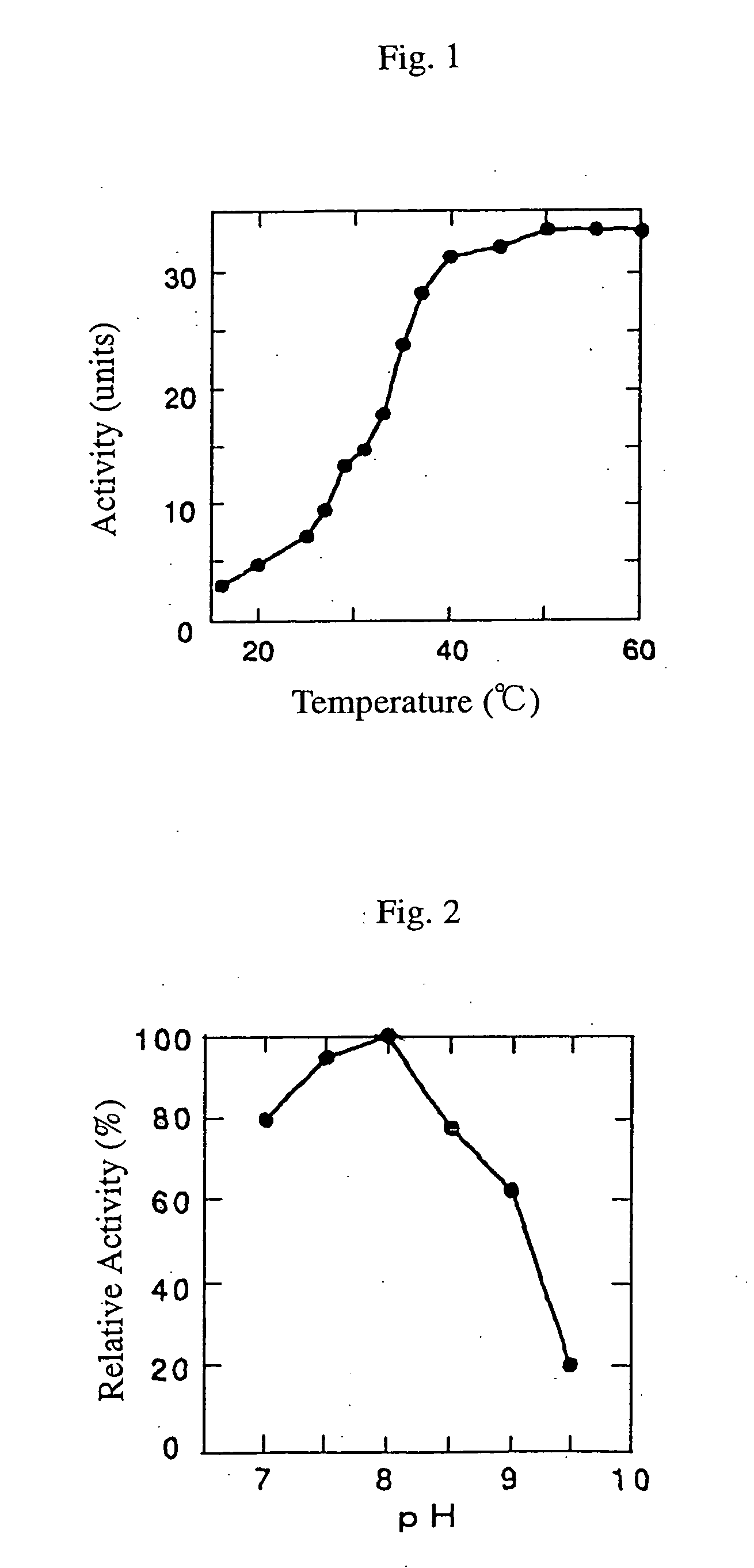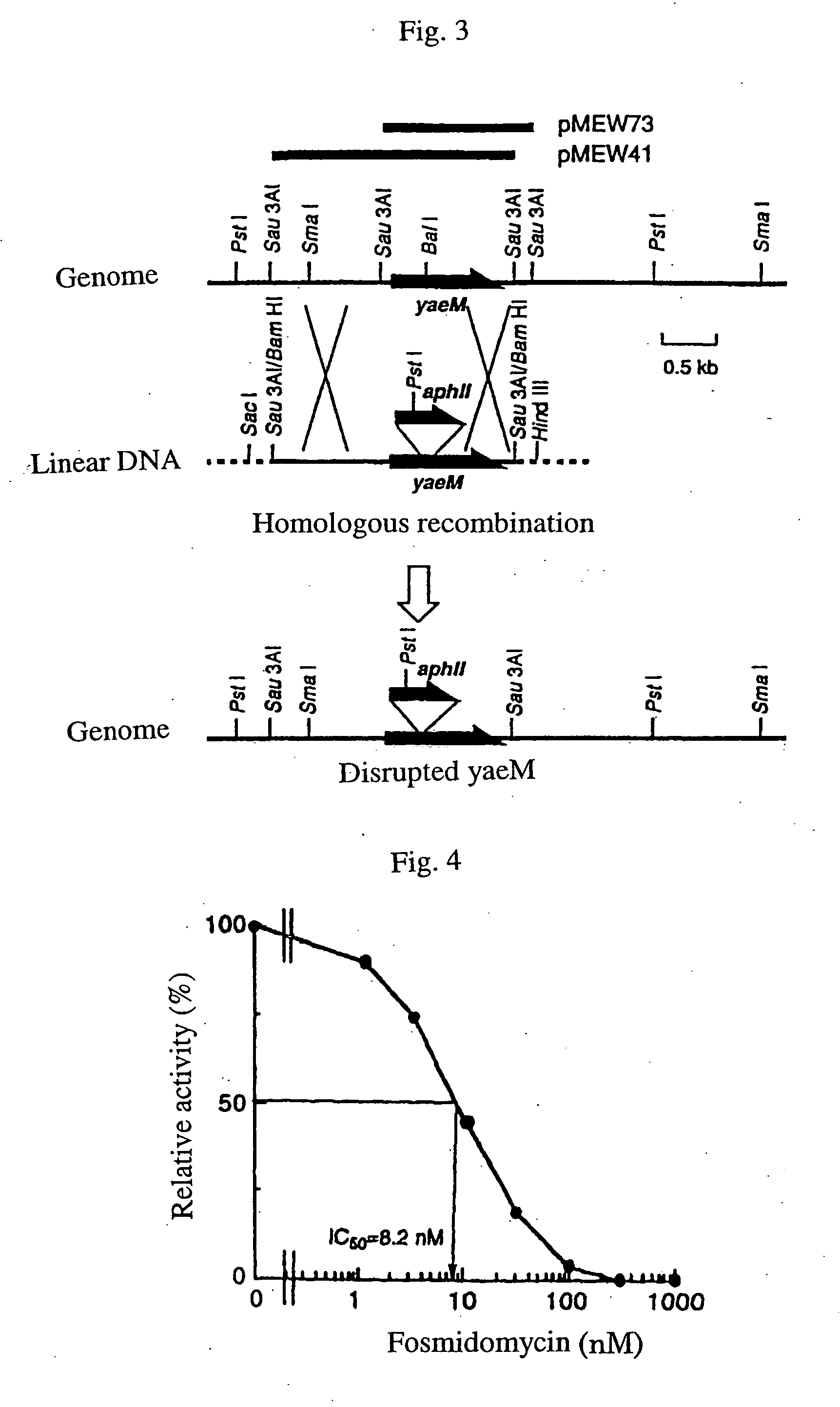Process for producing isoprenoid compounds by microorganisms and a method for screening compounds with antibiotic or weeding activity
a technology of isoprenoid compounds and microorganisms, which is applied in the direction of biocide, transferases, instruments, etc., can solve the problems of no example which improves the productivity of isoprenoid compounds, and no knowledge of how prokaryotes will be influenced, so as to improve biosynthesis efficiency
- Summary
- Abstract
- Description
- Claims
- Application Information
AI Technical Summary
Benefits of technology
Problems solved by technology
Method used
Image
Examples
example 1
Cloning of DNA Encoding Proteins Involved in the Biosynthesis of Isoprenoid Compounds
(1) Cloning of DNA Encoding Proteins Involved in the Biosynthesis of Isoprenoid Compounds Using the Nucleotide Sequence of E. coli DXS Gene
[0185] One platinum loop of E. coli XL1-Blue (purchased from TOYOBO) was inoculated into 10 ml of LB liquid medium, then cultured overnight at 37° C.
[0186] After culturing, cells were collected by centrifugation from the resultant culture.
[0187] Chromosomal DNA was isolated and purified from the cells according to the standard techniques.
[0188] Sense and antisense primers, each having BamHI and EcoR I restriction enzyme sites at their 5′-ends and consisting of nucleotide sequence pairs of SEQ ID NOS:12 and 13, 14 and 15, 12 and 16, 17 and 18, and 19 and 13; and sense and antisense primers, each having BamHI restriction enzyme site at their 5′-ends and consisting of a nucleotide sequence pair of SEQ ID NO:22 and 23; were synthesized using a DNA synthesizer. ...
example 2
Production of Ubiquinone-8 (CoQ8) Using Recombinant Escherichia coli
[0236] (1) E. coli DH5α were transformed using the plasmids pADO-1, pDXS-1, and pXSE-1, those obtained in Example 1 above, and pEG400 as a control, respectively, then E. coli DH5 α / pAD0-1, E. coli DH5 α / pDXS-1, E. coli DH5 α / pXSE-1 and E. coli DH5 α / pEG400 that showed resistance to spectinomycin at a concentration of 100 μg / ml were obtained.
[0237] These transformants were inoculated into a test tube containing 10 ml of LB medium supplemented with thiamine and vitamin B6, 100 mg / l each, 50 mg / l of p-hydroxybenzoic acid, and 100 μg / ml of spectinomycin. Then the transformants were cultured with shaking for 72 hours at 30° C.
[0238] After the culture was completed, each culture was concentrated 10-fold.
[0239] To each 300 μl of concentrated culture, 300 μl 2-butanol and 300 μL glass beads were added. Isoprenoid compounds were extracted with the solvent while disrupting the cells by Multi Beads Shocker MB-200 (YASUI KI...
example 3
[0249] Production of Menaquinone-8 (MK-8) by Recombinant Escherichia coli
[0250] (1) The E. coli DH5 α / pADO-1 or E. coli DH5 α / pEG400, obtained in Example 2 (1), was inoculated into a test tube containing 10 ml of TB medium supplemented with 100 μg / ml of spectinomycin, and then cultured with shaking for 72 hours at 30° C. The TB medium had been prepared by dissolving 12 g of bactotrypton (Difco), 24 g of yeast extract (Difco), and 5 g of glycerol into 900 ml of water followed by the addition of 100 ml of aqueous solution containing 0.17 mol / l KH2PO4 and 0.72 mol / l K2HPO4.
[0251] After the culture was completed, MK-8 was quantified in the same quantifying method for CoQ8 as in Example 2 (1), then the amount of MK-8 produced by the transformants was calculated.
[0252] Table 4 shows the results.
TABLE 4MK-8 Production by transformants of Escherichia coliCell AmountAmount of MK-8IntracellularTransformant(OD660)Produced (mg / L)Content*1E. coli23.21.10.46DH5 α / pEG400E. coli23.51.80.75DH5 ...
PUM
| Property | Measurement | Unit |
|---|---|---|
| concentration | aaaaa | aaaaa |
| temperature | aaaaa | aaaaa |
| pH | aaaaa | aaaaa |
Abstract
Description
Claims
Application Information
 Login to View More
Login to View More - R&D
- Intellectual Property
- Life Sciences
- Materials
- Tech Scout
- Unparalleled Data Quality
- Higher Quality Content
- 60% Fewer Hallucinations
Browse by: Latest US Patents, China's latest patents, Technical Efficacy Thesaurus, Application Domain, Technology Topic, Popular Technical Reports.
© 2025 PatSnap. All rights reserved.Legal|Privacy policy|Modern Slavery Act Transparency Statement|Sitemap|About US| Contact US: help@patsnap.com



